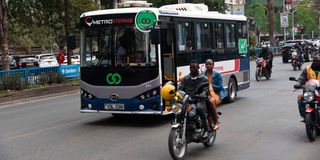Try cycling and bigger buses for urban mobility

An electric bus in the streets of Nairobi
In Kenya, a nation filled with vitality and potential, the issue of urban transportation is at a crucial crossroads.
As our cities expand, they grapple with mounting challenges such as congestion, pollution and the dire consequences of increased greenhouse gas emissions.
It’s a pivotal moment to shift gears and embrace innovative, sustainable solutions. It is imperative for the government to consider a dual strategy that combines high-capacity buses and bicycles, to significantly reduce urban carbon emissions and fostering cleaner, healthier cities for all.
Urban centres share a common adversary: Traffic congestion. This gridlock brings with it the silent but potent spectre of air pollution and escalating carbon emissions. Every year, our once-pristine cities edge closer to environmental deterioration.
The answer to this conundrum is deployment of high-capacity buses. While not a groundbreaking concept, their pivotal role in reducing congestion and carbon emissions cannot be overstated.
These modern, eco-friendly vehicles have the potential to transport a large number of passengers, offering a tangible solution to decongest burgeoning cities.
This necessitates comprehensive government support. It should encompass substantial investment in public transport infrastructure, affordable fares and the utmost accessibility of bus services. Government incentives can act as a catalyst for the private sector to contribute to providing high-capacity bus services, lessening the load.
The government should expedite the BRT project on Thika Road, Nairobi, which will set pace for such and more efforts geared towards decongesting our roads and significantly reducing emissions. It should also encourage and promote cycling as the face of clean and sustainable urban transformation. Often overlooked, cycling possesses immense potential to revolutionise our cities. Dedicated bike lanes, safety measures for cyclists, bike-sharing programs in urban hubs and a vibrant cycling culture all form part of this renaissance.
Adopting high-capacity buses and bicycles as sustainable urban transportation modes hinges on the formulation of a meticulously planned policy framework. Enforcing stringent emission standards for vehicles, penalising high-emission vehicles, implementing congestion pricing during peak hours and offering subsidies for public transit and bicycle commuting would best effect this change.
These sustainable transportation options would see Kenya make significant strides toward reducing carbon emissions, mitigating air pollution and improving the overall urban environment. Clean air and reduced traffic congestion are not just aspirations; they are fundamental rights of every Kenyan.
Kenya is on the brink of a new era in urban transportation. The concurrent integration of high-capacity buses and bicycles paints a promising picture of cleaner, healthier and more dynamic cities. It is incumbent upon us all to rally behind and advocate these transformative changes. For the government, it presents an opportunity to invest in a greener and more sustainable future.
- Mr Kasina is a development communication specialist. [email protected].




